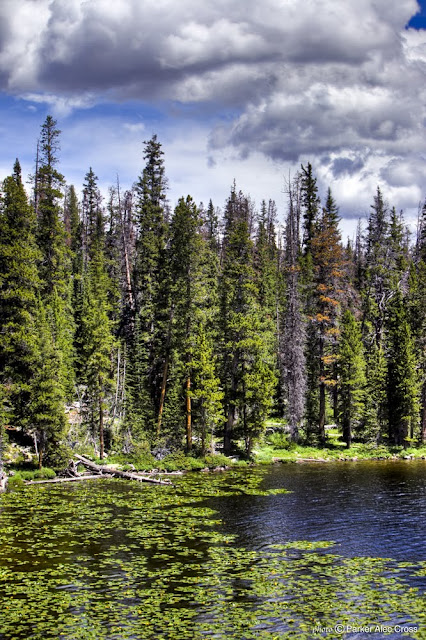There are some truly beautiful places in the world, and I personally think Utah kind of has a monopoly on scenery–the High Uintas, indeed, are no exception to this standard. I went to the Ashley National Forest with my backpacking class this past weekend, and had a marvelous time. I was, fortunately, able to finally field test my new hammock and mosquito net, as well as my new JetBoil Flash cooking system. All three performed wonderfully (just in case you were wondering). (remember to click on any image for a larger view)
The Uintas aren't exactly what I'd call a "pristine" wilderness area, because there are fully established trails weaving all throughout over 450,000 acres of wilderness preserve, but the lush environment certainly establishes a real sense of wild wooded country. People do indeed get lost and die in the zone every season (most due to improper planning, and wilderness savvy), but all-in-all, it's a fabulous area to take your family, your pets, and loved ones. Or, in our case, your class.
Garth Tino was our instructor for the semester and shared a lot of insight with regard to gear and know-how when it comes to having an enjoyable time in the backcountry. One of the things that I thought was pretty awesome was Garth's dedication to the principles of Leave No Trace. It's something of a new experience for me, although a lot of the principles are not.
The Leave No Trace: Outdoor Ethics list is as follows:
Plan Ahead and Prepare
- Know the regulations and special concerns for the area you'll visit.
- Prepare for extreme weather, hazards, and emergencies.
- Schedule your trip to avoid times of high use.
- Visit in small groups. Split larger parties into groups of 4-6.
- Repackage food to minimize waste.
- Use a map and compass to eliminate the use of rock cairns, flagging or marking paint.
Travel and Camp on Durable Surfaces
- Durable surfaces include established trails and campsies, rock, gravel, dry grasses or snow.
- Protect riparian areas by camping at least 200 feet from lakes, streams.
- Good campsites are found, not made. Altering a site is not necessary.
In popular areas
- Concentrate use on existing trails and campsites.
- Walk single file in the middle of the trail, even when we or muddy.
- Keep campsites small. Focus activity in areas where vegetation is absent.
In pristine areas
- Disperse use to prevent the creation of campsites and trails.
- Avoid places where impacts are just beginning.
Dispose of Waste Properly
- Pack it in, pack it out. Inspect your campsite and rest areas for trash or spilled foods. Pack out all trash, leftover food, and litter.
- Deposit solid human waste in catholes dug 6 to 8 inches deep at least 200 feet from water, camp, and trails. Cover and disguise the cathole when finished.
- Pack out toilet paper and hygiene products.
- To wash yourself or your dishes, carry water 200 feet away from streams or lakes and use small amounts of biodegradable soap. Scatter strained dishwater.
Leave What You Find
- Preserve the past: observe, but do not touch, cultural or historic structures and artifacts.
- Leave rocks, plants and other natural objects as you find them.
- Avoid introducing or transporting non-native species.
- Do not build structures, furniture, or dig trenches.
Minimize Campfire Impacts
- Campfires can cause lasting impacts to the backcountry. use a light-weight stove for cooking and enjoy a candle lantern for light.
- Where fires are permitted, use established fire rings, fire pans, or mound fires.
- Keep fires small. Only use sticks from the ground that can be broken by hand.
- Burn all wood and coals to ash, put out campfires completely, then scatter cool ashes.
Respect Wildlife
- Observe wildlife from a distance. Do no follow or approach them.
- never feed animals. Feeding wildlife damages their health, alters natural behaviors, and exposes them to predators and other dangers.
- Protect wildlife and your food by storing rations and trash securely.
- Control pets at all times, or leave them at home.
- Avoid wildlife during sensitive times: mating, nesting, raising young, or winter.
Be Considerate of Other Visitors
- Respect other visitors and protect the quality of their experience.
- Be courteous. Yield to other users on the trail.
- Step to the downhill side of the trail encountering pack stock.
- Take breaks and camp away from trails and other visitors.
- Let nature's sounds prevail. Avoid loud voices and noises.
If you're looking for some great cross-country backpacking, look no further than the High Uintas. Everything from forests, to lakes, to 13,000 ft summits. It's an outdoorsman's dream location, and it's right out our back door.






















